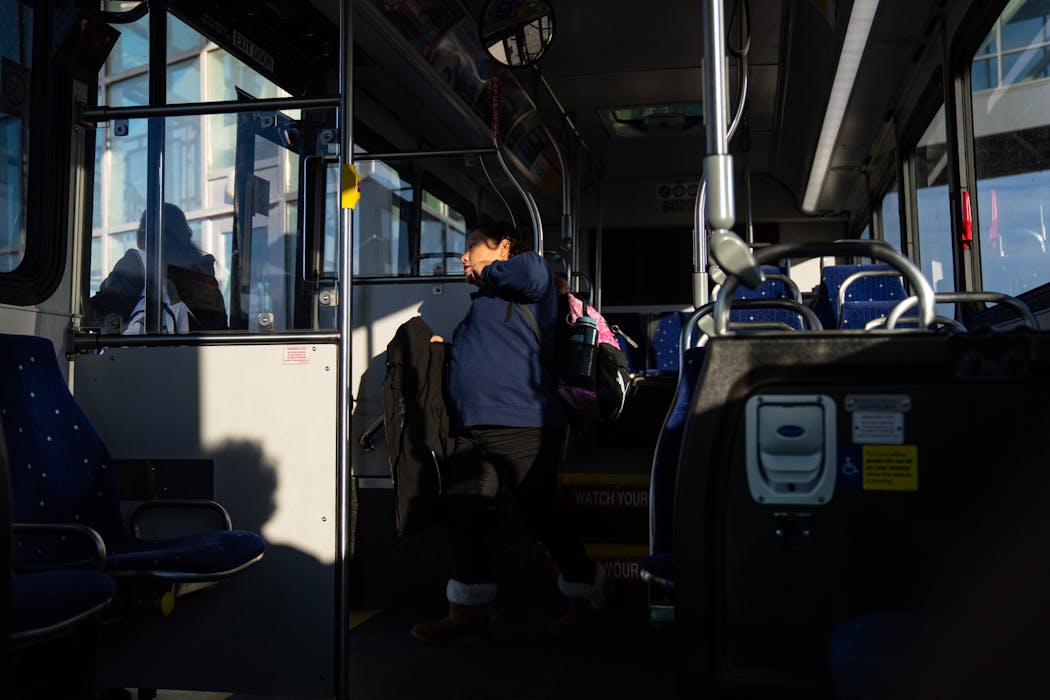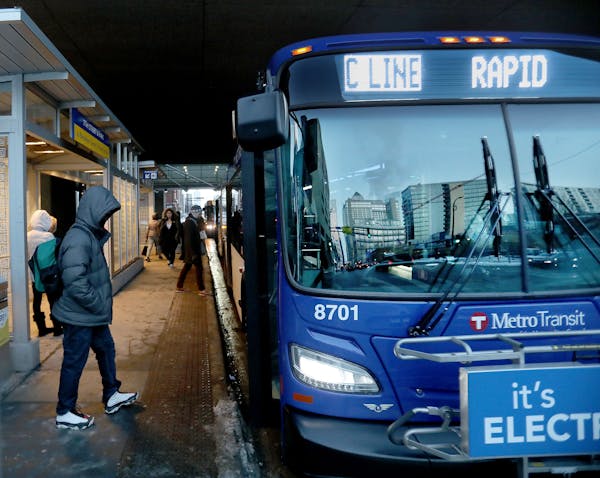Ann Marie Kopp boarded the Red Line bus for home Thursday afternoon after an invigorating turn around the Mall of America and lunch at IKEA.
As a 64-year-old with disabilities, the Rosemount resident has no other means of transportation. The Red Line — the Twin Cities' first bus rapid transit (BRT) line between the Bloomington megamall and Apple Valley — "is my lifeline," she said.
When the $112 million Red Line debuted a decade ago, it was seen by local transit planners as an experiment for future BRT service, which features fewer stops and all-day trips built for a fraction of the price of light rail. The fact that BRT service has expanded significantly in the Twin Cities since — with close to $1 billion in investment and more than a dozen lines operating or planned — suggests the Red Line has been a viable blueprint for expansion.
But the laptop-toting masses never materialized on the Red Line, even before the COVID-19 pandemic struck and the rise of remote work upended 9-to-5 commuter patterns. Frequent riders say the Red Line ferries them mostly to their jobs at the Mall of America or the outlet stores in Eagan, and to medical appointments. Last year, average weekday ridership was a modest 344 rides.
"If I was writing about the Red Line, I would say it's a lifeline for people," said bus driver Alex Tran, reiterating a common refrain among passengers. That means for families, people with disabilities, those struggling to make ends meet and immigrants, he added.
But others question whether the Red Line is a sound investment for taxpayers. "It was never successful even pre-COVID, and now it's even more challenged post-COVID," said Dakota County Commissioner Mary Liz Holberg, who has served on a number of transit boards over the years.
Many BRT modes
In transportation circles, bus rapid transit service implies buses using a dedicated roadway, a mode widely embraced in Latin America and China. Only the planned $505 million Gold Line between downtown St. Paul and Woodbury comes close to that definition locally, with a guideway hemming Interstate 94 planned for most of the route when service begins in 2025.
"Cost-wise, BRT is more bang for the buck," said Nicholas Dagen Bloom, a professor of urban policy and planning at Hunter College in New York. "BRT is really good for establishing new networks."
The Red Line travels mostly in traffic along Cedar Avenue, with the option of diverting to the highway's bus-only shoulder lanes. Bus operators say the vehicles are rarely crowded, save for occasional sporting events and concerts.
Before the pandemic, annual ridership aboard the Red Line was 242,372, but the outbreak resulted in a 51% plunge in riders. When service began in 2013, it took more than a year for the line to reach its inaugural ridership goal — a circumstance largely blamed on an awkward minutes-sucking detour at the Cedar Grove stop, where buses would leave the highway to drop passengers off near the outlet mall.
It would take the Metropolitan Council, the regional planning body that operates Metro Transit, four years to remedy the situation by building a $15 million skyway connection at Cedar Avenue connecting passengers to the Cedar Grove Transit Station and the outlet stores beyond.
Building convenient access for customers to destinations has been one of the challenges of the Red Line, said Adam Harrington, Metro Transit's director of service development.
"It's really been a learning experience," he said, adding, "It's more of a suburban, lower-density market where there are nodes of activity, and that shopping center is one of them,."
Another upgrade in 2019 involved a $25 million rebuild of the Mall of America Transit Center — the Red Line's northern terminus — improving on the previous station, a dank facility that required transit passengers to walk outside before entering the mall.
Apple Valley Mayor Clint Hooppaw says private development along the Red Line corridor has totaled about $400 million. An $8 million renovation in 2019 at the Apple Valley Transit Center was prompted by a high level of demand among residents, he said.
The city recently received $7 million from the state to help build a new pedestrian bridge at the 147th Street stations. As Harrington noted, in a suburban environment, it's critical to make "the pedestrian and bike environment blend in."
Pandemic fallout
Nine months after the pandemic struck, the Metropolitan Council decided to end its $3.2 million contract with the Minnesota Valley Transit Authority, the suburban provider that operated the Red Line since it began service. The council said the switch to Metro Transit would save money in a challenging budget environment.
MVTA characterized the move as a "body blow" to its business. Since then, some say the relationship between MVTA, which owns the Apple Valley Transit Center, and the council is tense. "It's like the Hatfields and McCoys," said Holberg.
But MVTA and Metro Transit officials say the two agencies now have a good working relationship. "We've come a long way," Harrington said.
Future of the Red Line
In the post-pandemic world, transit agencies are struggling to adapt to a new service paradigm. "If you look at how commuting has changed since the pandemic, I don't know anyone who will ride a commuter bus downtown five days a week — ever," said Holberg.
Metro Transit's Harrington concedes there has been a "big sea change in travel patterns" post-COVID. Improvement tends to be incremental, and "the same is true with the Red Line," he said. "It's slow, but we're coming back."
Ridership on the Red Line continued to plummet at the height of the pandemic to 112,706 in 2021, with average weekday ridership of 326 riders, and a subsidy per passenger of $25.38. Yearly ridership crept up about 8.5% percent last year, to 344 riders per weekday at a subsidy per passenger of $18.22.
The pandemic prompted Metro Transit to study how the transit agency will adapt to new ridership patterns, an effort called Network Now. The Red Line is part of that review, including long-ago talk about expanding the service to Lakeville. Recommendations are expected next spring.
"They should prioritize transit money for transit-dependent areas that want and need the service," Holberg said. "What would the system look like if they concentrated on what works?"

Minneapolis education support workers authorize strike
Officials ID 14-year-old shot and killed while in SUV at northeast Mpls. gas station
Minnesota Republican congressional candidates seek endorsements at Saturday conventions

'No Mow May' eases to 'Less Mow May' in some Twin Cities suburbs



